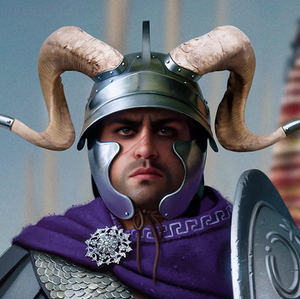Seleucus of Ioklos
Seleucus of Ioklos | |
|---|---|
 Seleucus adorned with a horned helmet | |
| Born | September 990 Ioklos, Symmerian Empire |
| Died | 5 July 1038 Haiga, Quenmin |
| Allegiance | Quenmin 1021-1038 |
| Service/ | Ancient Symmerian army |
| Rank | Strategos (general) |
| Battles/wars | Seleucus' Civil War |
Seleucus', also known as Seleucus of Quenmin or Seleucus the Liberator, was a Symmerian strategos (general) who instigated a civil war against the Symmerian Empire from 1021-1038.
Seleucus was born in Ioklos in northern Syara, the son of Symmerian nobility. Like many young men of noble birth he joined the Ancient Symmerian army at a young age, becoming a member of the Companions. Sometime between 1012-1015 Seleucus was assigned to Quenmin under the Viceroy Theognis as part of the Symmerian garrison present in the province. As a soldier of the Later Symmerian Empire Seleucus was tasked with enforcing the tenuous grip Symmeria held on its eastern territory, which by the 11th Century had grown increasingly rebellious. Between 1015-1021 Seleucus began gathering the support of local leaders in Quenmin and like minded Symmerians to overthrow the rule of Symmeria and establish an independent state in eastern Siduri.
Why Seleucus decided to betray his country and attempt to secede is a continuous source of debate among historians. There are generally two schools of thought; the liberators, who hold that Seleucus was motivated out of pity for the Quenminese peasantry and locals who were forced to bear the heavy costs of taxation and conscription, and the supremacists, who believe that Seleucus was motivated primarily by personal ambition and desire for power. Liberators generally refer to Seleucus' known efforts to increase the living conditions of Quenminese under his rule and his close relationship with several Quenminese figures, including Trịnh Hội. Supremacists point towards Seleucus' harsh treatment of many of his subordinates and his willingness to enact oppressive measures in order to fuel his war effort. A third, more modern theory holds that Seleucus was motivated by both compassion and sense of comradery for the Quenminese and his own desire for glory and fame.
Seleucus successfully mobilized forces loyal to him and in 1021 had them overthrow Theognis, after which Seleucus proclaimed independence with control of most of Quenmin. He then marched north to conquer much of Serikos from Symmerian rule, although found himself facing opposition from some Serikese. Seleucus' nephew Andriskos, one of his allies, was then killed fighting a Symmerian army in Quenmin, but his niece Zeuxo successfully rallied his forces to defeat the Symmerians near Kontin. Seleucus reinforced with army with tens of thousands of mercenaries from Eracura, Cacerta, Lirinya, and the Rideva Empire, after which he invaded Knichus but was stopped short of conquering the entire province. Seleucus then returned to fight an inconclusive campaign against the Symmerians in Tay Bien in 1025, then defeated a Symmerian invasion of Serikos in 1031 along with Zeuxo. Pratinas then invaded Quenmin in 1033, though he was defeated by Seleucus, Zeuxo and Trịnh Hội near Lairang. Seleucus was unable to prevent Pratinas from sacking Buon Ma Thuot, and was then defeated in Vũ Bá.
Seleucus fled to Nagarcam, then was defeated at My Xuyen and retreated towards Da Nang. Pratinas laid siege to Da Nang in 1035 but Seleucus was able to escape north before retreating to Haiga. He held the city as it was besieged by the Symmerians in 1037, and perished in the fighting. According to legend Seleucus removed his helmet and cloak before leading a final change against the Symmerians and was killed. His body, however, was never recovered, leading to rumors of his survival and escape for decades after his death. Zeuxo later surrendered, ending the civil war with a Symmerian victory.
Seleucus' actions nevertheless paved the way for the end of Symmerian rule in Quenmin. Trịnh Hội successfully evaded capture and would go on to tutor Hoạn Quốc Tổ in his later years, who would lead to the Âu Lạc Rebellion 42 years later. By 1080 Quenmin had broken free of Symmerian rule, a major event in the eventual Fall of the Symmerian Empire. The legacy of Seleucus remains a major point of pride among Quenminese Hellenes and is considered a national hero in Quenmin. Seleucus fathered several children with Quenminese women, establishing lineages that would continue throughout Quenminese history for centuries.